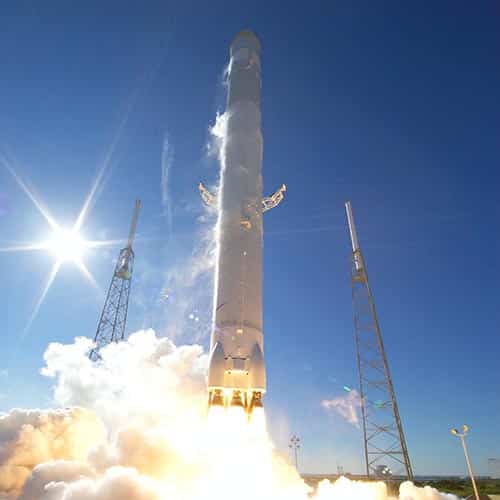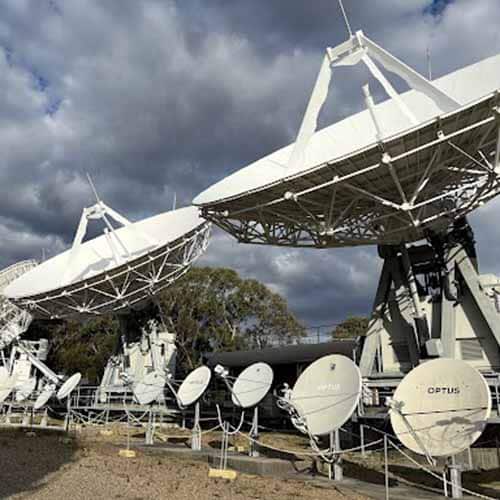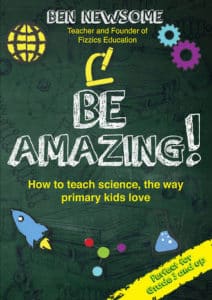Space captivates young and older students alike. Think of your very first memories as a kid and I bet you can remember a time when you looked at the stars or thought about rockets in space. From technology to mythology, space has that X factor that crosses cultural boundaries and generational age gaps. It’s just simply fascinating! Also, it is a hook that encourages students from all disciplines to look beyond the subject and to see the potential careers that they could be involved in.
Below are just some ideas that showcase to students the wide array of industries that space impacts and where there are growing career opportunities for them. This will also help when you counter the very common questions;
- Why spend money on space technologies?
- What is the benefit for us here on Earth?
As you showcase these space industries and their associated applications here on Earth, you just might surprise them as to how far and wide the space domain is for their everyday lives.
Aerospace Engineering
This one is fairly obvious but absolutely needs to be included. Designing and building aircraft, spacecraft, satellites, and more are critical for the space industry. As you talk about aerospace engineering, be sure to mention the work done to improve propulsion systems, structural design, instrumentation, ground stations and the different requirements for Geostationary orbits (GEO), Low Earth orbits (LEO) and more.
Some applications of Aerospace Engineering here on Earth;
- Automotive Industry
Technologies developed for spacecraft propulsion and structural integrity can improve vehicle design and safety. - Sports Engineering
Materials and technologies designed for spacecraft can be used in sports equipment, improving performance and safety.
Robotics

Image NASA: Robonaut by NASA in Johnson Space Center in Houston, Texas.
Robots grab students’ attention! Developing robots for space exploration is so important for space exploration. Students will readily identify the need for rovers on moons and planets, but may not realise the need for automated systems for spacecraft. This field combines mechanical engineering, electrical engineering, and computer science and this is a rapidly growing area
Some applications of robotics on Earth:
- Medical Robotics
Technologies developed for space rovers can be applied to surgical robots, enhancing precision in operations. - Automated Manufacturing
Robotic systems designed for spacecraft assembly can be adapted for use in automated production lines.
Telecommunications
We cannot use modern communications technologies without the space industry. Every day we we use satellites for communication purposes, including television, internet, and military communications. This industry involves signal processing, network engineering, and space-based infrastructure.
Some applications of telecommunications on Earth
- Remote Internet Access
Satellite communication technology can be used to provide internet access in remote or underserved areas. - Emergency Response Systems
Satellite communications can enhance disaster response capabilities by ensuring connectivity during emergencies.
Climate Science

Image NASA: Jetstream over North America
The world is keenly aware of climate change and we can monitor its ongoing changes from earth observation platforms in low Warth orbit. This helps in understanding weather patterns, climate change, and environmental management.
Some applications of climate science on Earth:
- Environmental Monitoring
Satellite data can be used for terrestrial environmental monitoring, helping manage forests, oceans, and wildlife. - Agricultural Forecasting
Using climate data to predict weather patterns can improve agricultural planning and yield predictions.
Defence and Security
Defence in space is about developing space-based technologies for national security and defence, including surveillance satellites and missile defence systems. Huge advances are happening in this area as nations look to secure their sovereignty.
Some applications of defence and security
- Cybersecurity
Technologies developed for securing space-based assets can enhance cybersecurity measures on Earth. - Border Surveillance
Satellite surveillance technologies can be adapted for border and maritime security.
Biotechnology

Image: NASA astronaut and Expedition 66 Flight Engineer Kayla Barron checks out plants growing inside the Veggie botany research facility for the Veggie PONDS experiment. The investigation tests ways to grow crops in space to supporting long-term crewed missions to the Moon, Mars and beyond.
Organisms respond differently to microgravity and as such space offers the opportunity to learn more about cellular and molecular responses to low gravity on biological systems. This research can lead to advancements in agricultural output, health sciences and pharmaceuticals.
Some applications of biotechnology:
- Pharmaceuticals
Research in microgravity environments can lead to new drug formulations and delivery systems. - Agricultural Biotech
Techniques for studying plant life in space can be applied to improving crop resistance and productivity.
Materials Science

Testing a shuttle tile under high heat
Materials science continues to develop as we look to develop new materials and technologies for use in extreme environments like space. This can have applications in other terrestrial industries such as manufacturing, mining and construction.
Some applications of materials science:
- Construction
Materials engineered for space applications can lead to stronger, lighter building materials for use in construction. - Consumer Electronics
Advanced materials from space research can be used in high-performance electronics and batteries.
Energy
View of the ISS solar array taken during SpaceX Crew 2 flyaround
Use of energy is highly intensive in space applications. New energy technolgoy can be tested in space and then deployed in cities around the world.
Some applications of energy
- Renewable Energy Solutions
Solar technology developed for space can enhance solar power systems on Earth. - Energy Storage
Battery technologies developed for space missions can improve energy storage solutions for renewable energy sources.
Art and Design
Virtual reality use in action
From digital twin technologies for mission planning to designing user interfaces for space systems, the creative arts have strong applications in the space industries. Students may not be aware that their interest in gaming and visual design could well lead to a career in the space sector.
Some applications for art & design
- Virtual Reality
Interface and experience design for space exploration can advance virtual reality and augmented reality technologies. - Design Software
Design techniques for space training modules can be applied in design & educational technology.
Legal and Policy
Less thought about but very much a real domain, space law is required to govern nation-states and organisations who are working in orbit. Students can learn about space law, regulations governing space activities, international treaties, and policy development for the ethical use of outer space.
Some applications for legal policies of space:
- International Regulation
Frameworks for space law can guide the development of regulations for emerging technologies such as drones and autonomous vehicles. - Environmental Policy
Policies developed for space debris management can inform similar approaches for environmental conservation on Earth.
Finance and Economics
Space is expensive and it takes funding to meet the challenges that are posed. Students can learn about managing the financial aspects of space missions and companies, including funding for startups, economic analysis of space ventures, and investment opportunities.
Some applications for finance and economics:
- Venture Capital
Investment strategies and financial models for space exploration can be adapted for other high-tech industries. - Risk Management
Techniques for managing the financial risks of space missions can be applied in other sectors requiring large capital investments.
Mining
The Moon, asteroids and beyond offer new avenues for resources for us to use. Technologies are rapidly being developed to extract minerals, metals and other precious resources for the lunar environment and beyond.
Some applications for space mining on Earth
- New extraction technologies
More efficient and environmentally friendly ways of extracting resources from the Earth. - Robotics
Remote mining requires robotics that need to be developed which can then be deployed on Earth.
Health and Medicine
Space offers the opportunity to study the effects of space travel on human health, so that we can develop medical technologies to support astronauts in space, and using space-developed technologies for healthcare on Earth.
Some applications for health and medicine:
- Telemedicine
Medical technologies developed for remote health monitoring of astronauts can be used to improve telehealth services. - Physical Therapy and Rehabilitation
Innovations in astronaut health maintenance can inform physical therapy techniques, especially for mobility-limited patients.
It’s about the hook
As teachers we need to be aware of students’ interests; it is always in their interests that you will gain the most engagement and therefore impact in your class. So, why not show the possible careers in space that they can have no matter what their interests are! After all, the space industry is growing incredibly quickly across the globe and the opportunities for students are immense.
From English & History to Geography & Art, you can apply space as a hook for teaching every subject.
Imagine the conversations you might have, let alone what you might spark in your student’s mind!
Looking for resources for teaching about space?
The following are resources that you can use now for teaching about space;
AVA Challenge
Complete a 9 step STEM design sprint based on challenges facing NASA’s Artemis and the Australian space industry. AVA teams will choose from a set of six scenarios and design a solution presented in the form of either a 90-second video pitch or poster.
Scenarios
- Earth Observation: Milo Institute – ASU
- Robotics: AROSE Lunar Rover Challenge
- Home on the Moon: Aldrin Family Foundation
- Growing Food in Space: Magnitude.io
- AI in Space
- Telecommunications in Space
Space School Visits
Learn about our Universe and space exploration techniques in these hands-on science workshops and shows
Stars & Planets
Destination Moon
Exolab Mission to the ISS
Through a network of science laboratories in your schools, science centers, libraries, and museums, students can join others around the world in a live mission aboard the International Space Station.
Visit Optus Belrose
Visit a working Earth Station at Optus Belrose Sydney & learn the science of satellites, rocketry and much more.
Happy teaching,
Primary science teaching book!
“Be Amazing! How to teach science, the way primary kids love”






































Comments